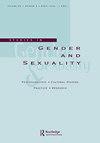过度的挑战:邀请拉普朗什的理论进入夫妻治疗领域
Q3 Social Sciences
引用次数: 1
摘要
摘要拉普兰切的几个关键思想——神秘的信息、政变、人类学的基本情况、翻译和被掏空的移情——可以应用于夫妻治疗。以一对夫妇为例,说明拉普兰切的概念在强调无意识交流的主体间性、发展性和关系性时,如何补充现有的夫妇治疗理论。本文章由计算机程序翻译,如有差异,请以英文原文为准。
The Challenge of Too Much: Inviting Laplanche’s Theory into the Realm of Couples Therapy
ABSTRACT Several of Laplanche’s key ideas—enigmatic messages, après coup, the fundamental anthropological situation, translation, and the hollowed-out transference—may be applied to the context of couples therapy. A case of one couple is presented to illuminate how Laplanche’s concepts, in their emphasis on the intersubjective, developmental, and relational nature of unconscious communication, may complement already existing theories of couples treatment.
求助全文
通过发布文献求助,成功后即可免费获取论文全文。
去求助
来源期刊

Studies in Gender and Sexuality
Social Sciences-Gender Studies
CiteScore
0.80
自引率
0.00%
发文量
15
期刊介绍:
Beginning in the final two decades of the 20th century, the study of gender and sexuality has been revived from a variety of directions: the traditions of feminist scholarship, postclassical and postmodern psychoanalytic theory, developmental research, and cultural studies have all contributed to renewed fascination with those powerfully formative aspects of subjectivity that fall within the rubric of "gender" and "sexuality." Clinicians, for their part, have returned to gender and sexuality with heightened sensitivity to the role of these constructs in the treatment situation, including the richly variegated ways in which assumptions about gender and sexuality enter into our understandings of "normality" and "pathology."
 求助内容:
求助内容: 应助结果提醒方式:
应助结果提醒方式:


